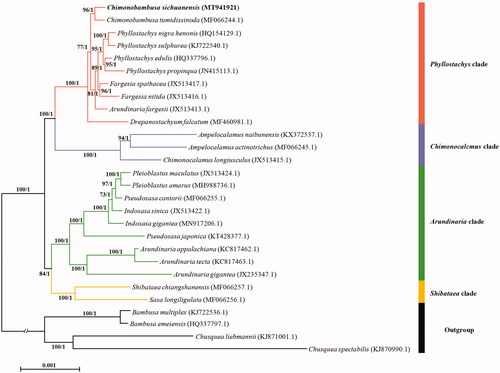Abstract
Chimonobambusa sichuanensis is an ornamental shrubby bamboo endemic to southern China. In this study, the complete chloroplast genome (cpDNA) sequence of Chimonobambusa sichuanensis was first reported. The cpDNA is 139,594 bp in length, including a small single-copy (SSC) region of 12,820 bp and a large single-copy (LSC) region of 83,196 bp, which were separated by a pair of inverted repeat (IR) regions of 21,789 bp. The genome contains 140 genes, consisting of 93 protein-coding genes, seven ribosomal RNA (rRNA) genes, and 40 transfer RNA (tRNA) genes. The phylogenetic analysis showed that C. sichuanensis is highly clustered in the Phyllostachys clade, sister to C. tumidissinoda.
Chimonobambusa sichuanensis (T. P. Yi) T. H. Wen, belonging to the family Poaceae (Bambusoideae: Arundinarieae), is regarded as a representative ornamental bamboo species for its graceful appearance and strong adaptability. The clear taxonomic status of this species is important to understanding the evolution of the genus Gelidocalamus. However, the classification of C. sichuanensis remains controversial (Yi Citation1982, Citation1992). The chloroplast genome sequence has been used to determine evolutionary relationships in many bamboo species, such as Dendrocalamopsis vario-striata (Lin et al. Citation2019), Gelidocalamus xunwuensis (Zhang et al. Citation2019), Bambusa tulda (Liu and Lan Citation2020), Acidosasa gigantea (Zheng et al. Citation2020), Phyllostachys edulis ‘Pachyloen’ (Huang et al. Citation2019) and Phyllostachys glauca (Cao et al. Citation2020), but not C. sichuanensis. In this study, we first sequenced and analyzed the complete chloroplast genome of C. sichuanensis genome-skimming sequencing to clarify the classification status of the species to promote the researches on the genus of Chimonobambusa.
Fresh and young leaf materials of C. sichuanensis were collected from the outdoor Bamboo Garden of Nanjing Forestry University, China (32°01′ N, 118°48′ E). The voucher specimen (JXAU-20201439) was deposited at the herbarium of the College of Forestry, Jiangxi Agricultural University, China. Illumina paired-end (PE) library was prepared and sequenced in the Nanjing Novogene Bio-technology Co., Ltd. (Nanjing, China). The complete chloroplast genome sequence was annotated using Geneious 9.0.5. The complete chloroplast genome sequence of C. sichuanensis was deposited in GenBank under the accession number of MT941921.
The complete genome sequence of C. sichuanensis was a circular DNA molecule of 139,594 bp in length, contains a small single-copy (SSC) region of 12,820 bp and a large single-copy (LSC) region of 83,196 bp, which were separated by a pair of inverted repeat (IR) regions of 21,789 bp. The overall GC content of the whole genome is 38.9%, and the corresponding values of the LSC, SSC, and IR regions are 37.0%, 33.2%, and 44.2%, respectively. The genome contained 140 genes, including 93 protein-coding genes, seven ribosomal RNA (rRNA) genes, and 40 transfer RNA (tRNA) genes.
To confirm the phylogenetic position of C. sichuanensis, a phylogenetic analysis was performed based on 24 complete chloroplast genomes as well as four species as outgroups, were downloaded from NCBI GenBank. The ML tree and Bayes tree were constructed by RAxML (Stamatakis Citation2014) and MrBayes 3.2.6 (Ronquist and Huelsenbeck Citation2003), respectively. The phylogenetic tree showed C. sichuanensis is clustered in the Phyllostachys clade, sister to C. tumidissinoda () with high bootstrap values. The internodes in the phylogenetic tree are short, indicating the probable recent rapid radiation during the evolution.
Disclosure statement
No potential conflict of interest was reported by the author(s).
Data availability statement
The genome sequence data that support the findings of this study are openly available in GenBank of NCBI at https://www.ncbi.nlm.nih.gov/ under the accession no. MT941921. The associated BioProject, SRA, and Bio-Sample numbers are PRJNA688799, SUB8802233, and SAMN17189334, respectively.
Additional information
Funding
References
- Cao BB, Ge TT, Ding SX, Guo CC. 2020. The complete chloroplast genome of Phyllostachys glauca (Bambusoideae), a dominant bamboo species in limestone mountains endemic to China. Mitochondrial DNA Part B. 5(3):3211–3212.
- Huang NJ, Li JP, Yang GY, Yu F. 2019. Two plastomes of Phyllostachys and reconstruction of phylogenic relationship amongst selected Phyllostachys species using genome skimming. Mitochondrial DNA Part B. 5(1):69–70.
- Lin RQ, Jiang YT, Zeng QM, Liu B, Liu ZJ, Chen SP. 2019. Complete chloroplast genome sequence of bamboo Dendrocalamopsis vario-striata (Gramineae: Bambusoideae). Mitochondrial DNA Part B. 4(2):2874–2875.
- Liu Y, Lan SR. 2020. The complete plastid genome of Bambusa tulda (Poaceae, Bambuseae). Mitochondrial DNA Part B. 5(2):1299–1300.
- Ronquist F, Huelsenbeck JP. 2003. MrBayes 3: Bayesian phylogenetic inference under mixed models. Bioinformatics. 19(12):1572–1574.
- Stamatakis A. 2014. RAxML version 8: a tool for phylogenetic analysis and post-analysis of large phylogenies. Bioinformatics. 30(9):1312–1313.
- Yi PT. 1982. Chimonobambusa sichuanensis Yi. Bull Bot Res. 2(4):105.
- Yi PT. 1992. A new genus of Chinese bamboo – Menstruocalamus. J Bamboo Res. 1992(1):38–41.
- Zhang YT, Guo CC, Yang GY, Yu F, Zhang WG. 2019. The complete chloroplast genome sequence of Gelidocalamus xunwuensis (Bambusoideae: Arundinarieae): a shrubby bamboo endemic to China. Mitochondrial DNA Part B. 4(2):3352–3353.
- Zheng X, Yang M, Ding YL, Lin SY. 2020. The complete chloroplast genome sequence of Acidosasa gigantea (Bambusoideae: Arundinarieae): an ornamental bamboo species endemic to China. Mitochondrial DNA Part B. 5(1):1119–1121.

